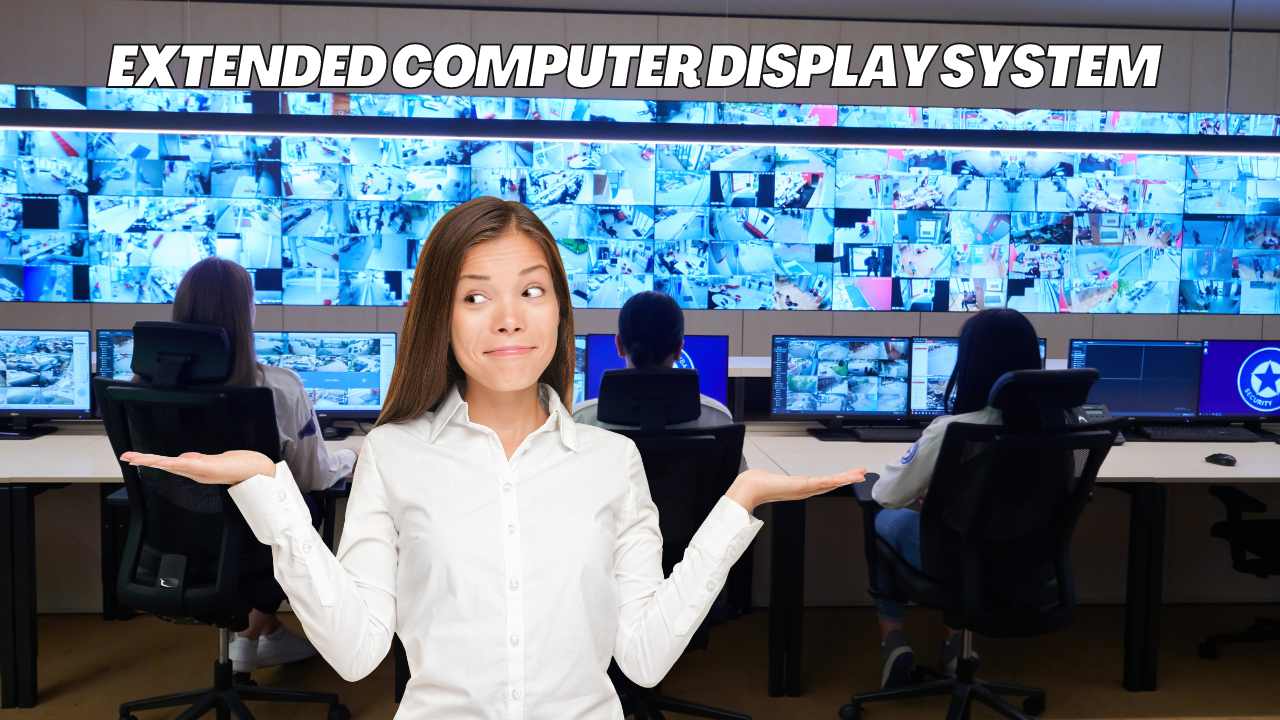Have you ever felt constrained by the limited screen space on your computer? Imagine being able to spread out your work, seamlessly dragging applications and documents across multiple screens. An EXCDS can make this a reality, boosting your productivity and enhancing your workflow.
What is an Extended Computer Display System(EXCDS)?
An EXCDS allows you to connect multiple monitors to a single computer, effectively extending your screen area. Unlike mirroring, where both screens display the same content, extending allows you to use each monitor independently. For example, you could have your email open on one screen and your spreadsheet on another, making multitasking a breeze.
Benefits of Using an Extended Computer Display Systems (EXCDS)
The advantages of using multiple monitors extend beyond just having more screen real estate. Firstly, it can significantly improve your efficiency. Studies have shown that dual-monitor setups can increase productivity by up to 42%. Secondly, it helps to reduce the clutter on your virtual desktop, making it easier to organize your work. Thirdly, it fosters better focus and multitasking, as you can dedicate different screens to different tasks.
EXCDS Project: A Comprehensive Guide
Setting up an extended display system might sound daunting, but it’s simpler than you think. The first step is to ensure your computer supports multiple monitors, which most modern systems do. Next, you’ll need the right cables and adapters to connect your monitors. Lastly, configure your settings to extend your display, which we’ll cover in detail later.
EXCDS PDF: Detailed Documentation
For those who prefer a step-by-step written guide, downloading a comprehensive PDF can be incredibly useful. Detailed documentation provides visual aids and troubleshooting tips, ensuring you have all the information you need at your fingertips. Most PDFs will cover everything from hardware requirements to software configurations.
How to Duplicate or Extend Display on Windows 10
Windows 10 makes it easy to either duplicate or extend your display. To duplicate, simply press Win + P and select ‘Duplicate’. This mirrors your primary screen onto the secondary monitor. To extend, select ‘Extend’ from the same menu. This allows each monitor to act as an independent display, giving you more screen space to work with.
Step-by-Step Guide: How to Use Extended Display
Using an extended display involves more than just connecting extra monitors. You’ll want to arrange your monitors in a way that mimics your physical desk setup. This can be done through the ‘Display Settings’ menu in your computer’s control panel. Drag and drop the monitor icons to match the physical layout. Adjusting the resolution and scaling settings will also ensure a seamless user experience.
How to Extend Screen on Windows 11: A Complete Tutorial
Windows 11 offers even more streamlined options for extending your screen. Access the ‘Settings’ menu and then go to ‘System’ followed by ‘Display’. From here, you can add and configure multiple monitors with ease. Windows 11 also offers advanced features like HDR support and better scaling, making it ideal for extended display setups.
How to Extend Screen on Windows 10: Simple Steps
If you’re using Windows 10, extending your screen is straightforward. Right-click on your desktop and select ‘Display Settings’. Under the ‘Multiple displays’ section, choose ‘Extend these displays’. Apply the changes, and you’re ready to go. You can also customize each monitor’s orientation, resolution, and scaling to suit your needs.
Hardware Requirements for an EXCDS
Before setting up an extended display system, it’s crucial to check your hardware. Ensure that your computer’s graphics card supports multiple monitors. You’ll also need the appropriate cables—HDMI, DisplayPort, or USB-C—to connect your monitors. Some older systems may require additional adapters or docking stations.
Software Solutions for Extending Your Computer Display
There are several software solutions available to enhance your extended display experience. Programs like DisplayFusion and UltraMon offer advanced features such as multi-monitor taskbars, customizable hotkeys, and window snapping. These tools can make managing multiple monitors more intuitive and efficient.
Troubleshooting Common Issues with Extended Display Systems
Even with the best setup, you may encounter some issues. Common problems include monitors not being detected, incorrect resolutions, or displays not aligning correctly. Most of these can be fixed through the ‘Display Settings’ menu. Updating your graphics drivers and checking your cable connections can also resolve many issues.
How to Optimize Your Workspace with an Extended Display
Optimizing your workspace involves more than just setting up your monitors. Consider ergonomics—position your monitors at eye level to reduce strain. Use monitor stands or mounts to free up desk space. Cable management solutions can help keep your workspace tidy. Personalize your setup with backgrounds and themes to make it uniquely yours.
Comparing Duplicate and Extended Display Modes
Understanding the difference between duplicate and extended display modes is key to maximizing your setup. Duplicate mode is useful for presentations or sharing your screen with others. Extended mode is ideal for multitasking and increasing productivity. Knowing when to use each mode can help you get the most out of your monitors.
Setting Up an EXCDS: Best Practices
When setting up your extended display system, follow best practices to ensure a smooth experience. Start by positioning your monitors correctly. Configure your settings to match your workflow. Regularly update your drivers and software to keep everything running smoothly. Following these steps will help you create an efficient and productive workspace.
Extended Display System for Gaming: Enhancing Your Experience
Gamers can also benefit from extended display systems. Multiple monitors can provide a more immersive gaming experience, offering a wider field of view. Ensure your graphics card can handle the additional load. Many modern games support multi-monitor setups, allowing you to fully exploit the potential of your extended display system.
How to Extend Your Laptop Screen: Windows 10 and 11
Extending your laptop screen is a great way to increase your productivity on the go. Both Windows 10 and 11 offer built-in support for multiple monitors. Simply connect your laptop to an external monitor using the appropriate cable. Configure your settings to extend the display, and you’re all set.
Advantages of Extending Your Computer Display for Productivity
The productivity benefits of an extended computer display are numerous. It allows for better multitasking, enabling you to run multiple applications simultaneously. It reduces the need to constantly switch between tabs or windows. Overall, it creates a more organized and efficient workspace, helping you get more done in less time.
Future Trends in EXCDS
The future of extended display systems is exciting. With advancements in technology, we can expect even more features and capabilities. Virtual and augmented reality are set to revolutionize the way we interact with multiple monitors. Staying updated with these trends will ensure you’re always on the cutting edge of productivity.
Conclusion
EXCDS offer immense benefits for productivity, gaming, and overall workflow efficiency. By understanding the basics, setting up your monitors correctly, and optimizing your workspace, you can transform your daily tasks. Ready to take the next step? Explore more resources, invest in the right hardware, and elevate your productivity game.


